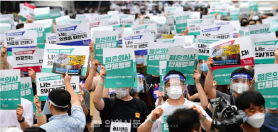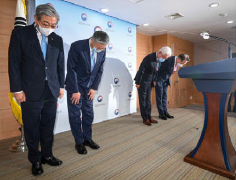During the parliamentary inspection of the Health and Welfare Committee, which was held from October 7th to 8th, four new medical policies that lit the fuse of the medical strike were discussed. From August, as a way to protest against the government’s policies, doctors began a strike, and medical school students either continued collective leave of absence or boycotted the nation’s medical licensing exam. Amidst the coronavirus disease 2019 (COVID-19) pandemic, the doctors’ strike resulted in severe medical chaos, and there are controversies surrounding this issue. The Sungkyun Times (SKT) is going to look into the causes of the strike, the opinions of both sides, and ways to alleviate the conflict.
About the Doctors’ Strike
What is the doctors’ strike?
Korean doctors went on a strike from August to protest against the policies of the Ministry of Health and Welfare which includes increasing the medical student quota and establishing a public medical school. Various medical groups including the Korean Medical Association (KMA), the Korean Intern Resident Association (KIRA), and the Korean Medical Student Association (KMSA) led collective actions. Earlier at the end of May, the government’s plans were becoming an issue, and they officially announced the new policies on July 23rd. On August 7th, trainee doctors began a strike, and the KMA followed on August 14th. As the COVID-19 outbreak worsened due to mass infection from Sarang Jeil Church, the government suggested holding an emergency meeting with the KMA. The negotiations, however, broke down and doctors continued the strike again from August 21st. Even though the government postponed the licensing exam considering the situation, 91.6% of medical students refused to take the exam. Among 3,036 senior medical students, 2,782 students boycotted the exam. This indicates that almost all students refused to take the exam, excluding failed or mature students. Similar large-scale medical strikes also occurred in 2000 and 2014, but this year’s strike during the pandemic crisis resulted in a big aftermath. As the core manpower of large hospitals stopped working, the strike led to medical chaos such as the delay of emergency operations.

Four Major Medical Policies That Doctors Disagreed with
1. Increasing Quota of Medical Students
According to the Organization of Economic Cooperation and Development (OECD) Health Statistics 2020, the number of doctors per 1,000 people is 2.3 in Korea. This figure is far below the OECD average of 3.4. Therefore, the government is planning to increase 400 new medical students annually from 2023, producing 4,000 more doctors within 10 years.
2. Establishing a Public Medical School
The government plans to open a public medical school to solve the doctor shortage problem in rural areas. To foster public doctors, the curriculum emphasizes the field of public health sectors. Public medical schools’ quotas will be divided into each administrative area proportionally, and the overall tuition is free.
3. Insurance Coverage of Oriental Medicine
Along with western medicine, the government plans to enhance the accessibility of oriental medicine. From October, oriental medicine for three diseases: facial paralysis, menstrual illness, and cerebrovascular disease will be covered by health insurance.
4. Introduction of Telemedicine
To protect from the infection of COVID-19 and the spread of the disease among the local communities, the government introduced nationwide telemedicine services from February. The government temporarily allowed doctors to treat patients via video consultations or phone calls.
Opinions of Each Side
Stances of the Government
The superficial reason for expanding the medical student quota is to solve the problems caused by the shortage of doctors. The number of students annually admitted to medical schools is 3,058, and it was fixed over 30 years ago, since 1989. Increasing the labor force for disease prevention and medical services is necessary considering the rise of medical demand in an aging society and the predicted decline of medical productivity. The main purpose of the policy is to narrow the regional gap of medical service availability, providing health care services to people in rural areas. Additionally, the government plans to conduct a study of the health care industry, which is expected to become a high-tech industry, and foster the medical scientists who can plan the developments of basic or applied medicine. In line with these aims, 300 of the additional 400 students will be required to work in provincial areas as a “regional doctor”. Among the remaining 100, 50 students will be required to specialize in epidemiology and major traumas, and 50 students will have to specialize in biomedicine and general medical science. Through the public medical school, Korea will directly produce public doctors and experts who will lead the public medical policies. In addition, the government believes that the insurance coverage of oriental medicine will provide more of a variety of medical services. Unlike the past, where insurance was not applied to oriental medicine, people will experience an ease in economic burden and have a broader variety of choices thanks to the insurance coverage. Finally, the government introduced telemedicine to follow the worldwide trend of technological development. These major policies aim to solve the chronic problems that existed within the healthcare system, considering the concerns of the doctors as much as possible. In the current situation where the number of COVID-19 patients is increasing daily, the government mentioned that doctors’ reason for the strike, which is to provide better services to patients, is not acceptable and suggested the suspension of the strike.

Stances of Doctors
Doctors judged that the government’s policies are nothing more than short-term solutions and that they are insufficient to solve Korean healthcare system’s fundamental problems. Even though the government will require both the increased quota and public medical school students to work in provincial areas and specialize in particular majors, predictions are that they will go back to the cities after the mandatory period of 10 years. Moreover, the actual period that the doctors have to work in rural areas for is five to six years when excluding the years of training as interns and residents. The education of public medical school students is also an issue. Students receive scholarships for their medical studies, but doctors emphasize that taxes should not be wasted only for a short mandatory period. The most important argument of doctors is that the lack of doctors in certain majors is due to the medical fee problem. A “medical fee” is the total amount a hospital receives from both patients and the National Health Insurance Service. In Korea, the cost of most medical practices is not being recouped due to low medical fees. Accordingly, doctors avoid operations critical to survival and cases that require subsequent operations. Because of this, there is a lack of participation in majors related to serious illness and trauma therapy, leading to a chronic shortage of doctors in majors such as urology, obstetrics, and gynecology. On the contrary, the number of doctors is concentrated in plastic surgery and dermatology, where medical fees are not set because procedures are not covered by insurance. To solve this problem, the government has to deal with the fundamental problem of medical fees rather than increasing the number of doctors. Regarding oriental medicine, safety and effectiveness are not verified yet, and the standards for maintenance and distribution are also not ready. Doctors additionally claim that telemedicine can result in misdiagnoses and data theft. Furthermore, telemedicine will only increase the popularity of large hospitals, enlarging the gap between hospitals.
Lessons from the Strike
Situation after the Strike
On September 7th, doctors agreed with the government to stop the indefinite strike and return to work. Despite their return, the concern still exists as the resistance of trainee doctors is fierce. Doctors argue that the agreement process was dogmatic and that new discussion was delayed without promise. Medical students also withdrew their leave of absence, and senior medical students expressed that they would like to take the exam. Directors of major hospitals apologized and requested the government to give students a chance to take the exam concerning their future. The government, however, decided that it would be difficult to give a second chance to students who previously boycotted, and public opinions are negative toward the attitudes of medical students. The strike decreased the credibility of doctors, and it is time for them to return to work and play their original roles.

How the Healthcare System Should Proceed
The main cause of the strike was the government’s implementation of policies that were not fully discussed with the public. To solve the problems of the healthcare system, enough discussion is necessary. In addition, deciding priorities among various factors such as forms of supply, policies, and workforce is important. The different groups, including the public that utilizes the healthcare system, doctors who provide the service, and the government which supervises the overall system should all come together to make an agreement. For the expansion of the public health service, which is the main purpose of the government, poor medical infrastructure and work conditions in rural areas should be reformed. Moreover, without the qualitative and quantitative expansion of public hospitals, simply increasing the quota of medical school students would be meaningless. In the long run, the government must implement the respective selection of general doctors and regional doctors.
The medical strike during the grave pandemic situation resulted in medical chaos, and many people criticized the doctors’ behavior. The strike explicitly revealed the problems of Korea’s healthcare system. Moreover, it showed the impact of policies without discussion, and how the collective actions of doctors can threaten public health. Rather than deeming the strike as the protest of “selfish” doctors, it should be considered an important process for better medical policies. It is necessary to find ways to alleviate the conflicts and make proper agreements.
